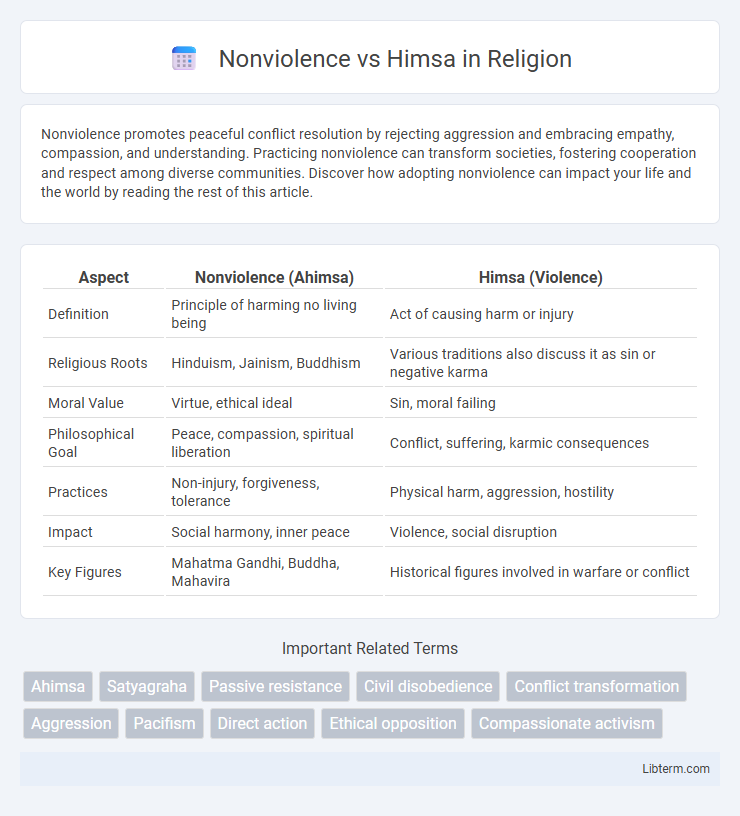Nonviolence promotes peaceful conflict resolution by rejecting aggression and embracing empathy, compassion, and understanding. Practicing nonviolence can transform societies, fostering cooperation and respect among diverse communities. Discover how adopting nonviolence can impact your life and the world by reading the rest of this article.
Table of Comparison
| Aspect | Nonviolence (Ahimsa) | Himsa (Violence) |
|---|---|---|
| Definition | Principle of harming no living being | Act of causing harm or injury |
| Religious Roots | Hinduism, Jainism, Buddhism | Various traditions also discuss it as sin or negative karma |
| Moral Value | Virtue, ethical ideal | Sin, moral failing |
| Philosophical Goal | Peace, compassion, spiritual liberation | Conflict, suffering, karmic consequences |
| Practices | Non-injury, forgiveness, tolerance | Physical harm, aggression, hostility |
| Impact | Social harmony, inner peace | Violence, social disruption |
| Key Figures | Mahatma Gandhi, Buddha, Mahavira | Historical figures involved in warfare or conflict |
Understanding Nonviolence and Himsa: Definitions
Nonviolence (Ahimsa) is a philosophical principle rooted in causing no harm or injury to living beings through actions, words, or thoughts, promoting peace and compassion. Himsa refers to intentional harm or violence that inflicts physical, emotional, or psychological damage on others, contradicting ethical and spiritual values. Understanding these concepts clarifies the ethical distinction where nonviolence fosters harmony and himsa perpetuates conflict and suffering.
Historical Roots of Nonviolence
Nonviolence, rooted in ancient Indian philosophies like Jainism and Buddhism, emphasizes ahimsa, the principle of causing no harm to any living being, fostering compassion and moral discipline. In contrast, himsa denotes harm or violence, historically used as both a social and political tool often justified by power dynamics in various civilizations. The historical roots of nonviolence gained global prominence through Mahatma Gandhi's application of ahimsa in the Indian independence movement, inspiring civil rights movements worldwide.
Philosophical Foundations of Himsa
Himsa, rooted in ancient Indian philosophical traditions, represents intentional violence or harm that disrupts social and cosmic order (Dharma), contrasting sharply with Ahimsa's principle of nonviolence and respect for all life forms. Philosophically, Himsa is often justified in texts such as the Arthashastra and certain interpretations of the Manusmriti, where controlled violence is seen as necessary for maintaining law, order, and justice. This ethical acceptance of Himsa acknowledges the complexities of human society, asserting that some harm may be required to prevent greater chaos and uphold societal stability.
Nonviolence in Spiritual and Religious Traditions
Nonviolence (Ahimsa) is a core principle in spiritual and religious traditions such as Hinduism, Buddhism, and Jainism, emphasizing compassion and respect for all living beings to achieve spiritual purity and liberation. It advocates for refraining from harm in thought, word, and deed to promote inner peace and social harmony. The practice of Nonviolence fosters empathy, encourages forgiveness, and is seen as a path to enlightenment and moral integrity, contrasting sharply with Himsa, which involves intentional violence and harm.
Psychological Impacts of Violence and Nonviolence
Nonviolence promotes psychological well-being by reducing stress, anxiety, and trauma, fostering empathy, resilience, and emotional regulation. In contrast, Himsa, or violence, induces psychological distress, including PTSD, aggression, and fear, leading to long-term mental health issues. The practice of nonviolence supports healing and social cohesion, while exposure to violence erodes trust and damages community mental health.
Nonviolence as a Tool for Social Change
Nonviolence as a tool for social change harnesses the power of peaceful resistance to challenge injustice and promote equality without perpetuating harm. It relies on moral discipline, collective action, and strategic non-cooperation to dismantle oppressive systems effectively. Historical movements led by figures like Mahatma Gandhi and Martin Luther King Jr. demonstrate that nonviolent methods can achieve profound societal transformation by appealing to shared humanity and ethical principles.
The Cycle of Himsa: Causes and Consequences
The cycle of Himsa originates from anger, fear, and ignorance, which lead to acts of violence and suffering. These acts perpetuate further harm, generating retaliation and ongoing conflict that disrupts social harmony. Breaking this cycle requires adopting principles of nonviolence, fostering empathy, and addressing the root emotional and psychological triggers.
Modern-Day Applications of Nonviolence
Nonviolence, rooted in principles of compassion and respect for all life, serves as a powerful strategy in modern-day social justice movements and conflict resolution efforts, contrasting sharply with Himsa, which involves violence and harm. Modern applications include peaceful protests, civil disobedience, and dialogue facilitation that aim to promote human rights, environmental sustainability, and political change without physical aggression. Organizations such as the Civil Rights Movement in the United States and global climate advocacy groups exemplify the successful use of nonviolence to achieve lasting societal transformation.
Challenges in Practicing Nonviolence
Practicing nonviolence faces challenges such as deeply ingrained cultural norms that often equate strength with aggression and societal systems that reward competitive, violent behaviors. Psychological barriers, including fear and anger during conflict, make maintaining nonviolent discipline difficult, especially when confronting Himsa, or active harm. The lack of immediate tangible results from nonviolent methods can also discourage consistent practice, requiring profound patience and resilience.
Building a Nonviolent Future: Steps Forward
Building a nonviolent future requires embracing principles of ahimsa, promoting peace through education, dialogue, and community engagement to replace the cycle of himsa, or violence. Implementing conflict resolution strategies and fostering empathy strengthens social cohesion and curtails aggression. Sustainable nonviolence depends on policy reforms, inclusive governance, and empowering marginalized voices to create resilient, peaceful societies.
Nonviolence Infographic

 libterm.com
libterm.com